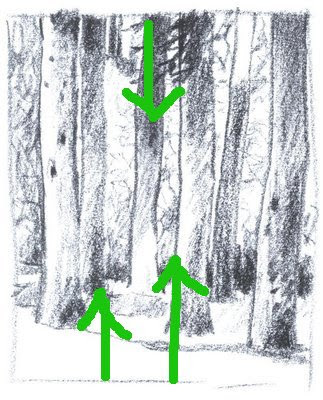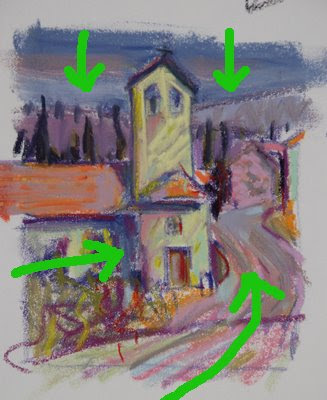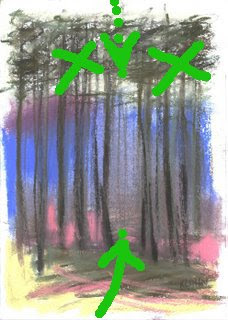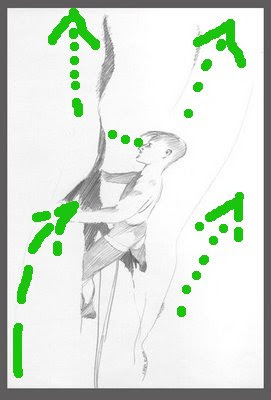
Astrid Volquardsen at the shore of Föhr
Pastellbilder-Pastell Blog
Astrid Volquardsen:
I live in the north of Germany in a small village called Bardowick, which is near Hamburg, where I grew up. Hamburg itself is a large city with a maritime touch and I recall many hours spent with my dad down at the harbor or taking trips to the North Sea with my family. So, it was a logical thing to focus on maritime landscapes, because that's where my heart lies and my soul is at peace.
State of pastel art in Germany
I started with pastels 20 years ago when I participated in a life drawing class. I just loved the way I could quickly fill in color. Immediately I fell in love with pastels and no other medium has had the same effect on me ever since.
For reasons I really don't know, pastels don't have a very high reputation in Germany. It's has not been considered to be "high art" by art colleges or galleries, but I didn't care and stuck to it anyway.
I think this has something to do with authenticity-about which you wrote in your blog, Casey. (You said) to listen to your inner-self and follow that path.
Back then I just knew this material was the perfect fit for myself, my art and what I would like to do and tried to not to listen too much to what my college teachers said about it. (College teachers still do not speak very nicely about pastels.)
To make it worse, realism might lead to a very lonely road, even though its getting better.
Pastels are still not widely known or as popular as watercolor or acrylic and there are only a few pastel artist in Germany. Gallery owners frequently told me: "I like your what?.... Pastels?...., but do you paint in oils?" After I heard that a couple of times, I started to educate the buying public and gallery owners, which actually is quite a lot of fun and a welcome change after lonely hours in my studio.
Two years ago I started to promote the pastels of Sennelier (I mostly paint with that brand). We have a widespread art supply store, which has branches all over Germany. There, I give speeches and do demonstrations of what is generally possible with pastels. I cover aspects like the different kind of pastel brands and grounds and how pastels can be applied. I show examples of American pastelists and people are really amazed at the possibilities. In addition, I point out to various websites and in the future I will highlight some blogs. Recently I started a blog and I have my own Website.
The funny thing about blogging is, that again, it's not that widely known and accepted in Germany as it is in America. I haven't hardly found any good blogs of German artist and they don't leave their comments as you guys do in America. Some artist have started to blog in German and English, but right now I don't know about that. I like to reach my German audience, so I try to figure out, how I can take away their shyness. But all these efforts have shown effects and I get emails from many people, who feel encouraged to use pastels. And I have found galleries who like my work and haven't asked me so far, if I paint in oils.

Sturmtag
11.6 x 30 inch
Soft Pastel
© Astrid Volquardsen
Casey Klahn:
I think Astrid's outlook is that of a pioneer for contemporary pastels in Germany. Her positive attitude is evident in the vast scope and beauty of her landscapes. She has that urge to create with her medium, with faith that the public will follow her vision. I know that the work being done in other countries to promote pastel will eventually create a sudden and rewarding market in Germany, and Astrid at the forefront.
Who are some artists that inspire you that use pastels?
Astrid Volquardsen:I can't say that there is just one pastel artist, who inspires me. When I was in England 15 years ago, (there was no Amazon.com so far :-), I run across a pastel instruction book. The pictures of Sally Strand left a great impression on me. This impression was so big, I still can recall the look of this tiny book shop. My remaining time in London I didn't spend with sightseeing, but in search of bookshops with painting instruction books or anything that had to do with pastels. The customs officer at Heathrow must have thought that I had gone mad, when he saw my suitcase, packed with books!Realism in art hasn't had a very high prestige and there in this book shop, I saw what I always wanted to do and paint. Realistic looking pastel pictures.
I love Sally Strand for the way she paints light and keeps to the values. It always amazes me.
Another painter I highly admire is the French pastelist Claude Texier. Again, all her paintings are about light and luminosity.
Then there is Daniel Greene and Gwenneth Barth. How can someone possibly paint these portraits and capture the likeness and even one's personality? I had the pleasure to watch Gwenneth Barth during a demonstration in Paris last year. It was very interesting for me to see, how she builds up the layers of pastel. Like Daniel Greene she blends only with the pastel sticks. That's something I would like to add to my work.
In Margaret Dyers work I love the way she uses the colors and her loose pastel strokes. From Wolf Kahn and your pictures Casey, I feel inspired by the way you both use color and are finding color combinations that seem to be so easily found.
So from all these artist, I take bits and pieces and all this flows into my work now or maybe in the future.
Interview to be continued in the next post.




























































